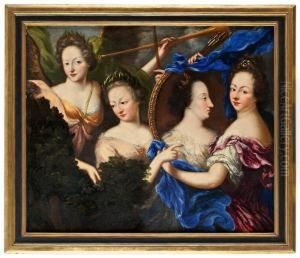Amalia Wilhelmina Von Konigsmarck Paintings
Amalia Wilhelmina von Königsmarck, born on August 20, 1663, in Stade, was a member of the noble Königsmarck family of the Swedish nobility, and she was also known for her artistic talents, particularly in the fields of painting and poetry. Amalia Wilhelmina was one of four children, and her family was well-connected in European aristocratic circles. Her siblings included the famous Count Philip Christoph von Königsmarck, who was rumored to have had a romantic relationship with Sophia Dorothea of Celle, wife of the future King George I of Great Britain, and Maria Aurora von Königsmarck, who became a celebrated patron of the arts and the mistress of Augustus the Strong, Elector of Saxony and King of Poland.
Coming from an environment that valued the arts and education, Amalia Wilhelmina received a comprehensive education for a woman of her time, which included artistic training. She became skilled in painting, an accomplishment that was considered both a genteel hobby and a reflection of her social status. Although she painted primarily for personal enjoyment and as a means of participating in the cultural practices of the aristocracy, some of her works have been preserved, indicating that she achieved a level of proficiency appreciated by her contemporaries.
Amalia Wilhelmina's life, like those of her siblings, was marked by the dramatic and sometimes tragic events that befell her family. Her brother Philip Christoph disappeared in 1694, an event shrouded in mystery and scandal due to his connection with Sophia Dorothea. Despite the dramatic events surrounding her family, Amalia Wilhelmina lived a relatively long life and continued her involvement in the arts throughout. She never married, which was somewhat unusual for women of her status during that era, and she outlived her siblings.
Amalia Wilhelmina von Königsmarck died on February 20, 1740, in Hamburg. While she is not as widely remembered as some of her contemporaries, her contributions to the arts during her lifetime were part of the broader tapestry of cultural patronage and artistic practice among the European nobility of the 17th and 18th centuries. Her life reflects the intersection of noble birth and the cultural expectations of aristocratic women during the Baroque period.
